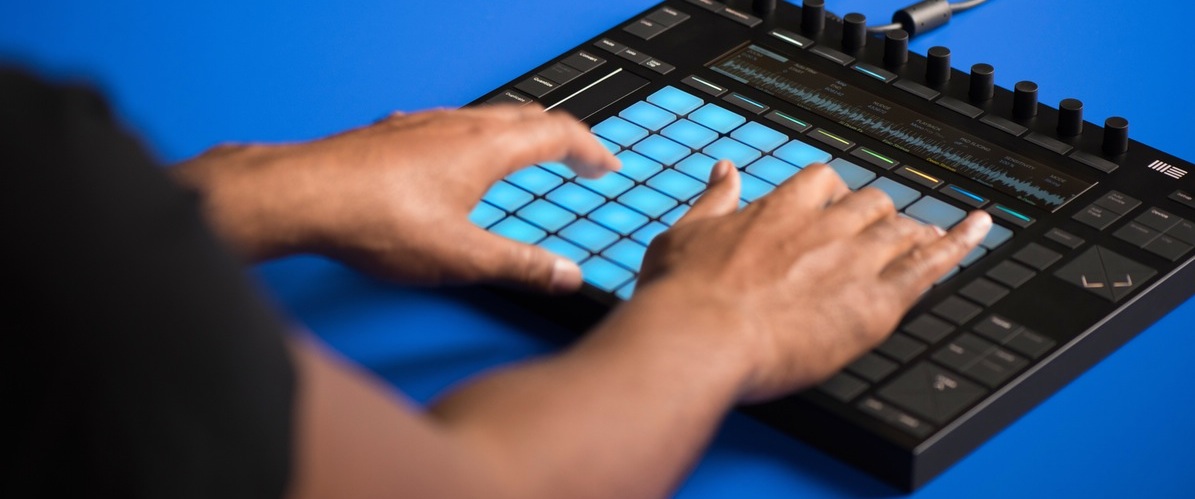Review: Ableton Push 2
The company unveils its primped-and-preened upgrade of the original.

Alongside the point release of Live 9.5, Ableton chose the very last day of its recent Loop conference in Berlin to unveil its first entirely in-house piece of hardware: the second iteration of Push. It’s a primped and preened upgrade of the original, with a sharp color display, better pad feel and even sturdier construction. The results, perhaps unsurprisingly, are very impressive: this is the most detailed, integrated way to control Live’s “Session View” workflow to date.
How It Looks
Beautiful, really—aesthetically, Push 2 is very much in a class of its own. While it’s essentially the same form factor as the original Push—weight, size, and general layout are roughly the same—everything feels more precise, more dialed-in. Buttons are lower profile than those of the original; they only peek slightly above the faceplate. Text on the various function buttons is extremely sharp, and disappears when those functions aren’t active. The finish is scratch-resistant and has a premium feel. The LEDs underneath the pads are brighter, and consistent across the face of their rubberized exterior. Where the original Push was the result of a collaboration with Akai, Push 2 was designed and produced entirely by Ableton—and, as a consequence, feels very much 2.0.
Easily the most noticeable upgrade comes in the form of Push 2’s display, which is fantastic and a huge leap past the monochromatic, lo-fi display of the original. There definitely appears to be some design inspiration taken from Teenage Engineering’s OP-1, and the result is something that feels cleaner and more future-forward than pretty much any MIDI controller out there. Data is all illustrated and color-coded, making the whole experience feel that much more natural and intuitive. If German/Scandinavian-style minimalism is your thing, these photos are probably already making you pant, and be assured that this high level of design consistency is followed through from hardware to software workflow.

How It Plays
The new Push improves working with sampled audio via its integration with an overhauled Simpler, in part by displaying the waveform on its screen. It’s easy to manipulate samples in looped/”Classic,” one-shot, or sliced format, and the Live Warp mode settings let you set how it’s stretched, played, and sliced.
Right from the Push screen you load your sample, choose your mode, and then head off to play with said sample in real-time, or step sequence it using as many pads as are required. Getting around the parameters of the Simpler (or whatever instrument you’re using) quickly becomes second nature, and helps achieve what is a significant goal: getting your eyes away from the computer, and helping you maintain a musical flow state.
Perhaps most importantly are the pads, which feel better than ever. Less stiff than those of the original, they’re extremely sensitive, and don’t wiggle in the slightest no matter how hard you hit them. Where the pads on the original Push lent themselves to punching in notes, the pads on Push 2 are far better for playing melodic parts—the difference between banging on finger drums and gently playing keys on a keyboard is a significant one, and Push 2 handles both of these interactions with aplomb.
The Bottom Line
Push 2 has become the new controller to beat for command over Ableton Live. If you have the original Push, it’s perhaps not necessarily a no-brainer, given the price; this is by no means a reboot of the original, but rather a refinement that’s better in lots of small ways. The old Push is still great, and gets plenty of upgrades with the release of Live 9.5; that said, Ableton is offering 30 percent off the new hardware with the trade-in of your old Push, or less if it’s in crap condition. Even better, your used original Push hardware will be donated to music education projects for young people.
Push 2 is not necessarily meant to replace all your other MIDI gear, but it definitely can if you need it to: for playing and manipulating samples, drums, and synthesizers, it’s an exceedingly capable machine. As has been the case with many things over the years—The Empire Strikes Back, Tony Hawk’s Pro Skater 2, to name but a couple—the second time is very much a charm for Push. It represents a significant step closer to letting you spend your music-making time communing with your instrument rather than squinting at your computer screen, distracted by the series of tubes that gurgle inside it—and that alone makes it a big deal.

Pricing: MSRP: $799 Street: $799

